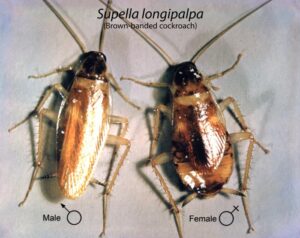Brown-Banded Cockroach
Supella longipalpa
Color: Light Brown or Golden Brown
Shape: Oval small and flat body.
Size: 10-14 mm in length.
Nutrition: They feed on starch, glue, books, food scraps, etc. They prefer sugary foods.
Habitat: They live globally all over the world.
They prefer warm and dry environments.

Brown-Banded Cockroach Behavior ?
- They are usually active at night. In densely infested areas they are also seen during the day. They move very fast and are agile.
Their habitats are mostly warm and dry areas. They thrive in warm and dry areas such as inside furniture, inside electronics, inside sockets. - They have a very varied diet. They prefer starch, sugar and oil-based products.
- Males have the ability to fly. They can fly short distances when disturbed. Females are flightless and have less developed wings.
- Females produce oothecae. They leave these pouches in furniture, cracks, etc. in quiet places. Their eggs hatch fast and increase their population in a very short time.
- They do not live as a colony but usually scattered. They do not like well-lit areas. When disturbed, they move quickly and escape into crevices.
- They like and prefer temperatures above 27°C. They generally like to live indoors.
Threats from Brown-Banded Cockroaches
Disease Transmission
- Pathogens: Salmonella – E.coli – Cross Contamination
– Allergens – Respiratory Problems – Exacerbation of Asthma - They have the potential for rapid reproduction. Thanks to their ability to hide, they can invade very quickly. Electronic devices are difficult to combat because they are difficult to detect in high cabinets.
- They cause a musty smell. They cause stress and anxiety in the environment. Contaminate food sources by depositing feces or eggs on food. Contaminated water and food should not be consumed.
- As they are stored in hot and dry environments, they damage the internal components and sensitive parts of electronic equipment.
Signs of an Infestation
- Being seen alive during the day
- Finding dead cockroaches
- Appearance of egg sheaths (Oothecae)
- Chew marks or small holes in the materials
- Damage to electronic devices
- Formation of moldy odor
- Dark stains on walls and surfaces
